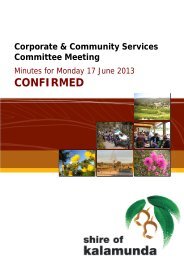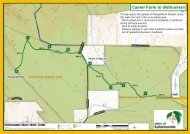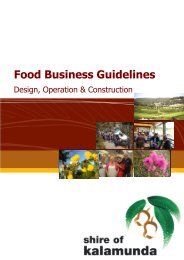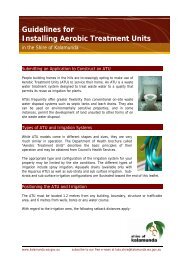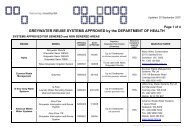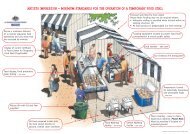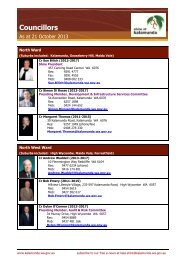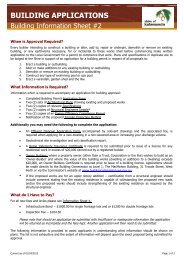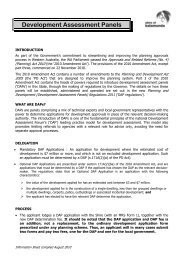Local Biodiversity Strategy: - Shire of Kalamunda
Local Biodiversity Strategy: - Shire of Kalamunda
Local Biodiversity Strategy: - Shire of Kalamunda
Create successful ePaper yourself
Turn your PDF publications into a flip-book with our unique Google optimized e-Paper software.
• The policy should refer to all vegetation not just trees, this will align it with<br />
clause 5.19 in the <strong>Local</strong> Planning Scheme No. 3 and State legislation;<br />
• The policy should relate only to locally endemic vegetation;<br />
• The policy should align with the EPA’s broad principles for protection <strong>of</strong><br />
terrestrial vegetation and flora which include but are not limited to:<br />
o Maintaining biodiversity at sustainable levels (greater than 30% <strong>of</strong> the<br />
ecological extent) where possible;<br />
o Conserving biodiversity insitu; and<br />
o Preventing loss <strong>of</strong> biodiversity (especially ecological communities with<br />
less than 10% <strong>of</strong> the original extent remaining); and<br />
• The policy should apply to all residents in the <strong>Shire</strong> as per the State<br />
legislation.<br />
To assist the <strong>Shire</strong> monitoring, and improve public awareness <strong>of</strong> vegetation removal<br />
within its boundaries a modification <strong>of</strong> the standard approval conditions to clearing<br />
permit requirements could be considered. Any clearing operation should be required<br />
to display clearly visible signs with the clearing permit number displayed. This will<br />
enable the <strong>Shire</strong> and community alike to monitor illegal clearing.<br />
11.5 Amendments to the <strong>Local</strong> Planning Scheme No. 3<br />
The ability to meet the biodiversity targets will be improved by making some<br />
adjustments to the <strong>Local</strong> Planning Scheme No. 3.<br />
Amendments could include altering the objectives <strong>of</strong> the Special Rural Zone to<br />
include protection <strong>of</strong> the environment. In this way the Forrestfield vegetation<br />
complex and occurrences <strong>of</strong> DRF and TEC that occur in this zoning have a higher<br />
likelihood <strong>of</strong> protection.<br />
It may also be prudent to alter the <strong>Local</strong> Planning Scheme No. 3 to reflect the<br />
requirement for planning approval for all clearance <strong>of</strong> endemic vegetation. This will<br />
add weight to the current requirements <strong>of</strong> the Tree Preservation Policy and the<br />
proposed Tree and Vegetation Preservation Policy (refer to Section 11.4.2).<br />
The current <strong>Local</strong> Planning Scheme could also be strengthened by adding the<br />
requirement for a full ecological assessment for all subdivision and development<br />
applications on rural land. This amendment would be especially important in helping<br />
enable the protection <strong>of</strong> the rare Forrestfield and Southern River vegetation<br />
complexes on land zoned Special Rural. It would also add more weight to the<br />
proposed <strong>Local</strong> Planning Policy for <strong>Biodiversity</strong> Conservation.<br />
The potential for incorporating Cluster Developments into local planning processes<br />
would ideally be supported through modification to the <strong>Local</strong> Planning Scheme No. 3.<br />
An example how this possible this is detailed in Box 17, which is an abstract from<br />
the City <strong>of</strong> Swan’s <strong>Local</strong> Planning Scheme No. 9.<br />
<strong>Local</strong> <strong>Biodiversity</strong> <strong>Strategy</strong> Page 73



